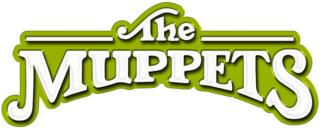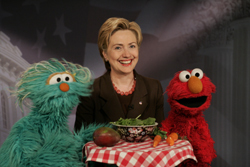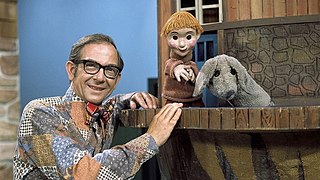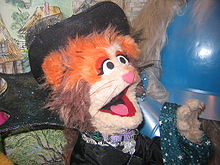
The Muppets are an American ensemble cast of puppet characters known for an absurdist, burlesque, and self-referential style of variety-sketch comedy. Created by Jim Henson in 1955, they are the focus of a media franchise that encompasses television, film, music, and other media associated with the characters. Originally owned by the Jim Henson Company for nearly five decades, the franchise was purchased by the Walt Disney Company in 2004.

Sesame Street is an American educational children's television series that combines live-action, sketch comedy, animation and puppetry. It is produced by Sesame Workshop and was created by Joan Ganz Cooney and Lloyd Morrisett. It is known for its images communicated through the use of Jim Henson's Muppets, and includes short films, with humor and cultural references. It premiered on November 10, 1969, to positive reviews, some controversy, and high viewership. It has aired on the United States national public television provider PBS since its debut, with its first run moving to premium channel HBO on January 16, 2016, then its sister streaming service HBO Max in 2020.

Elmo Monster is a red Muppet character on the children's television show Sesame Street. A furry red monster who speaks in a high-pitched falsetto voice and frequently refers to himself in the third person, he hosts the last full five-minute segment on Sesame Street, "Elmo's World", which is aimed at toddlers. He was most often puppeteered by Kevin Clash, but since Clash's resignation in late 2012, Elmo has been puppeteered by Ryan Dillon.

The preschool educational television program Sesame Street was first aired on public television stations on November 10, 1969, and reached its 54th season in 2023. The history of Sesame Street has reflected changing attitudes to developmental psychology, early childhood education, and cultural diversity. Featuring Jim Henson's Muppets, animation, live shorts, humor and celebrity appearances, it was the first television program of its kind to base its content and production values on laboratory and formative research, and the first to include a curriculum "detailed or stated in terms of measurable outcomes". Initial responses to the show included adulatory reviews, some controversy and high ratings. By its 40th anniversary in 2009, Sesame Street was broadcast in over 120 countries, and 20 independent international versions had been produced. It has won eleven Grammys and over 150 Emmys in its history—more than any other children's show.

Ernest Arthur Coombs, CM was an American-Canadian children's entertainer who starred in the Canadian television series Mr. Dressup (1967–1996).
The Friendly Giant is a children's television program that aired on CBC Television from September 30, 1958, through to March 1985. It featured three main characters: a giant named Friendly, who lived in a huge castle, along with his puppet animal friends Rusty, and Jerome. The two principal puppets of the CBC version of the show were manipulated and voiced by Rod Coneybeare. Originally in Wisconsin, they were manipulated and voiced by Ken Ohst.

Mr. Dressup is a Canadian children's television series, starring Ernie Coombs, a former understudy of Fred Rogers, in the title role. It ran on CBC from 1967 to 1996, soon becoming an iconic presence in Canadian media.

The Jim Henson Company is an American entertainment company located in Los Angeles, California. The company is known for its innovations in the field of puppetry, particularly through the creation of Kermit the Frog and the Muppets characters.

The Canadian Broadcasting Centre, also known as the CBC Toronto Broadcast Centre, is an office and studio complex located in Toronto, Ontario, Canada. It serves as the main broadcast and master control point for the Canadian Broadcasting Corporation's English-language television and radio services. It also contains studios for local and regional French-language productions and is the headquarters of the North American Broadcasters Association. Two floors of the facility house the ad agency Bensimon Byrne and its subsidiaries Narrative and OneMethod.
Vila Sésamo is a Brazilian co-production of the first preschool television programme Sesame Street. As of 2009 it airs on TV Rá-Tim-Bum. As of 2016, similar to Plaza Sésamo, new seasons air under the title Sésamo. The series debuted on October 12, 1972, moving from TV Cultura to SKY Play on June 25, 2020.

Play with Me Sesame is an American children's television series, created by Sesame Workshop and Nickelodeon for their former joint venture Noggin. It is a spin-off of Sesame Street hosted by Ernie, Bert, Prairie Dawn, and Grover. The series' backgrounds and animated elements were made by Nickelodeon Digital in New York City. Nickelodeon and Sesame Workshop developed the show to expand on Sesame Street by directly encouraging young viewers to interact with the characters. To do this, they combined classic Sesame Street sketches with new segments, where the hosts invite preschoolers to join them in games.

The CBC Museum was dedicated to the preserving the physical heritage and archival materials relating to the history of the Canadian Broadcasting Corporation (CBC). It was located in the Canadian Broadcasting Centre at 250 Front Street West, Toronto, Ontario, Canada. The museum collection began by at least 1960, the current display space opened in 1994, and closed on December 22, 2017.
Bob Stutt is a Canadian puppeteer and writer, who has starred in various children's television programs throughout his career.
CBC Kids is a Canadian children's block on CBC Television. The block was launched as Hodge Podge Lodge in 1987 and contains programming targeted at children. The block airs on weekdays from 7:00 a.m. to 11:00 a.m., Saturdays from 6:00 a.m. to noon and Sundays from 6:00 a.m. to 8:00 a.m.

Big Bag is an American live-action/animated children's television series created by Nina Elias-Bamberger for Cartoon Network and Children's Television Workshop. It was targeted at preschool viewers. The show was co-produced by Cartoon Network and CTW, with Muppet characters created by the Jim Henson Company. It aired from 1996 to 1998, with reruns airing through 2001, alongside another program titled Small World. Localized versions of Big Bag aired on Canal J in France and Yorkshire Television in the UK.
Sesame Street international co-productions are adaptations of the American educational children's television series Sesame Street but tailored to the countries in which they are produced. Shortly after the debut of Sesame Street in the United States in 1969, television producers, teachers, and officials of several countries approached the show's producers and the executives of the Children's Television Workshop (CTW), renamed Sesame Workshop (SW) in 2000, about the possibility of airing international versions of Sesame Street. Creator Joan Ganz Cooney hired former CBS executive Michael Dann to field offers to produce versions of the show in other countries.
Tim Gosley is a Canadian puppeteer who is primarily known for his work on numerous Muppet productions. He is originally from Victoria, British Columbia. Gosley earned a Bachelor of Fine Arts in acting from the University of Alberta and studied puppeteering with Richard Hunt from 1981 to 1983. He began his career portraying several minor characters on the television program Fraggle Rock from 1983 to 1987. He then began portraying Basil the polar bear on Sesame Park, the Canadian version of Sesame Street, a role he performed regularly for nine seasons.

SimSim Humara, also known as Sim Sim Hamara; meaning Our Sim Sim) is the Pakistani version of the children's television series Sesame Street. It is produced by Pakistan Children's Television and Rafi Peer Theatre.

Cheryl Wagner, is a Canadian puppeteer, producer, director and writer, who is the creator of the TV series The Big Comfy Couch, is a Gemini Award and Emmy award- winning Canadian children's television writer, showrunner and producer who began her career as a performer in both theatre and on the screen. Her Halifax-based touring Merrytime Clown and Puppet Company in which Wagner worked as a clown and puppeteer from 1977 to 1980 provided a fertile ground for her later work as a producer and writer in children's entertainment.
Daniel McCarthy was a Canadian radio and television producer and the former head of children's programming at CBC Television (CBC). He worked at the CBC for thirty-three years, including a twelve-year tenure as the head of the CBC's children's programming department. McCarthy created, developed and produced such well known Canadian children's television shows as The Friendly Giant, Mr. Dressup, and Sesame Park.













